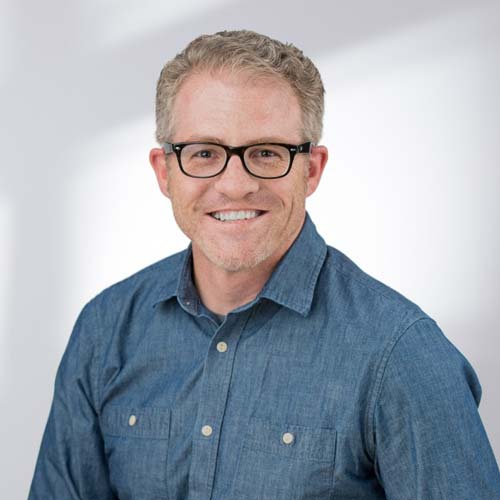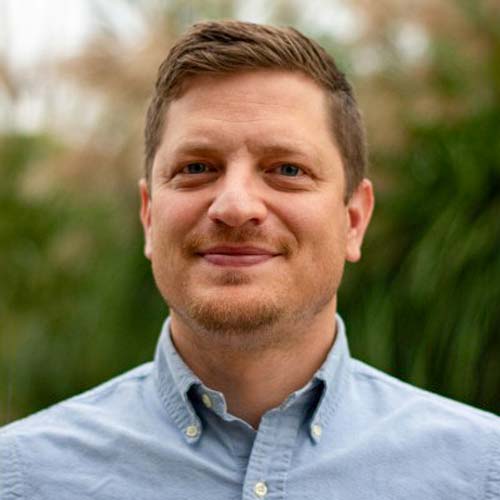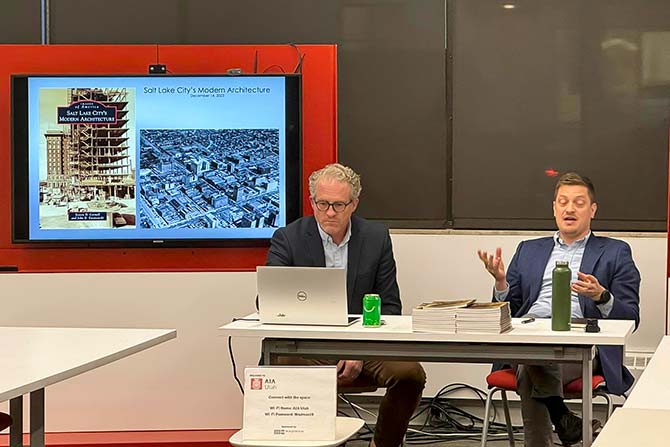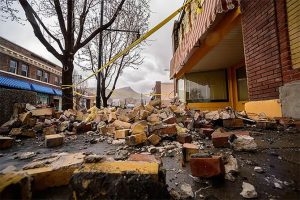
Steven Cornell, AIA

John Ewanowski, AIA
Steven Cornell and John Ewanowski, the co-authors of “Salt Lake City’s Modern Architecture,” call their new book a passion project. It was spawned by a presentation in 2016 at a preservation conference in Houston on modern buildings. Cornell wanted to execute a similar project here in Salt Lake and, with Ewanowski and in collaboration with Preservation Utah in 2017, launched a crowd-sourced project called “Uncommon Modern.” They put out an all-call for photos of buildings that fit into the post-war era and amassed hundreds from interested community members. Since that time, they have curated an online presence that catalogs modern architecture in the Salt Lake Valley.
In 2019, Cornell and Ewanowski decided to compile a book that highlights Salt Lake City structures built from (approximately) 1945 through 1975 that were influenced by Modernism, a movement defined by an analytical and functional approach to architecture. The Salt Lake Valley population tripled during this period, and as a result, there were thousands of new buildings constructed. Cornell and Ewanowski are quick to say that this is not a comprehensive databank of Modernism’s buildings but a good-sized sampling of the significant structures and examples from the bodies of work of many of the architects practicing over the 30-plus-year period the book chronicles.
“The 20th century in Salt Lake City was all about progress, creating a commercial center, advancing its status. Salt Lake’s population exploded; the city was coming of age and changing pretty rapidly. There was a theme of replacement. Planners led the way. A lot of it was inspired by AIA Utah, proactively planning cities after the war,” Ewanowski said.
Mid-Century Modern Architecture is certainly not universally appreciated. Critics consider the modernist buildings cold, plain and mundane.
Cornell said, “It is very functional, not constrained by the rules and regulations of classical architecture. It has to stand on its own two feet. It is laid bare.”
Ewanowski said, “Modernism was an approach that was meant to be achievable and built for the masses. But making something simple is very difficult.”
Architects and builders were experimenting with materials, like concrete, both in the structure and the aesthetic of the building. It takes effort to gain an appreciation for modernism as the aesthetic has a lot to do with the function.
Ewanowski said, “You have to like the clean lines, the natural light, the materials speaking for themselves. It is a movement that is looking to the future — creating forms that characterize the future. The International Style has a balance to it — it is an interplay of vernacular forms. People will say it is “just so ugly,” yet current architectural design owes more to Mies van der Rohe than to Richard Kletting (architect of the Utah State Capitol). It is closer to modernism.”
Considering 21st-century architecture’s reliance on rectangular forms, lack of embellishment, horizontal composition, open floor plans, large glass windows and natural materials, there is an argument to be made that there has been a natural progression from Modernism to the designs we now see world-wide for commercial, institutional, industrial, hospitality and multi-unit residential projects.
Cornell believes that one of the best Salt Lake City examples of the period is the First Security Bank Building at 405 South Main. “That is why it is on the cover.” First Security Bank was looking to the future and commissioned Wenceslao Sarmiento to design an office building that features a glass curtain, volumetric shapes, asymmetrical composition and lack of traditional ornament — all hallmarks of the era. The local architect was Slack Winburn.
Modernism evolved constantly during the period. There are styles, substyles and variations created specifically for this area. For instance, Bob Browning designed the Steiner American Building at 505 East South Temple, with brick and concrete to fit into the South Temple aesthetic and pressed it into the hillside so it would not have an overbearing presence with its neighbors. Some buildings were embellished with stonework that reflects a Salt Lake‑specific regionalism and that developed independently.
The authors noted that there is a transient nature to most buildings, and this seems particularly true of the commercial and institutional buildings that were constructed during this 30-year period in Salt Lake City. Many have been demolished. The iconic Fisher Brew House only lasted until the 1970s. A lot of the buildings at the University of Utah were designed and built quickly. As a result, sometimes the materials didn’t hold up very well. “They were not sustainable in the truest sense of the word,” Ewanowski said.
Renovating and upgrading Modern buildings to meet contemporary seismic and building codes is expensive, as it is for buildings built previous to this era, and often owners do not see the value in preserving these structures even though most have reached the 50-year point where they can be listed on the National Register of Historic Places. Nonetheless, iconic buildings like First Security Bank and the Steiner American have been placed on the National Register and seismically upgraded in recognition of the contributions they have made to Salt Lake City’s built environment and have been renovated to meet contemporary commercial needs.
Salt Lake architects that they recognize as having contributed to the modernist movement include Slack Winburn, John Sugden, Lloyd Snedeker and many of the early grads of the University of Utah’s Architecture School, which was founded by Roger Baily. This includes architects whose work spans both the mid-century period and the later 20th century, like Jim Christopher and Jud Daniels.
The road to publication was dogged but not altogether smooth. In addition to the disruptive effect of the pandemic, on March 18, 2020, Salt Lake City had a 5.7 magnitude earthquake. The earthquake significantly damaged the Rio Grande Depot that houses the Utah State Historical Society’s Reading Room, interrupting their research. The materials had to be relocated to safeguard them during the reconstruction. After the new facility was opened, Cornell and Ewanowski worked diligently with the Historical Society’s staff to identify, access, select and gain permission to use over 180 photographs that were published in “Salt Lake City’s Modern Architecture.”
Arcadia, the same publisher that produced Allen Roberts’s “Salt Lake City’s Historic Architecture,” published Cornell and Ewanowski’s book. The three architects/preservationists worked together at CRSA — an architecture firm with a specialty in historic and existing buildings. Since then, Roberts has retired, and Cornell and Ewanowski have moved to other firms. Cornell said, “Although we didn’t work with Allen on this effort, this book might be considered a continuation of his work. The format of Roberts’s ‘Historic Architecture’ matched what we wanted to do. It’s a follow-up.”
Cornell and Ewanowski focused on commercial and institutional architecture from the period. Although there are some multi-unit residences in the book, single-family mid-century homes are so ubiquitous and currently fashionable that it would “require another book.”
Copies of “Salt Lake City’s Modern Architecture” can be purchased online or at local booksellers such as The King’s English Bookshop (www.kingsenglish.com) and Weller Book Works (www.wellerbookworks.com).








